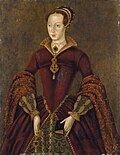Mary I of England
Mary I (18 February 1516 – 17 November 1558), also known as Mary Tudor of Greenwich, was Queen regnant of England and Ireland from 19 July 1553 until her death. She was the oldest daughter of Henry VIII and the only child of Catherine of Aragon who survived childhood.
| Mary Tudor | |
|---|---|
 | |
| Queen of England And Ireland | |
| 19 July 1553 – 17 November 1558 | |
| 30 October 1553 | |
| Predecessor | Jane (disputed) or Edward VI |
| Successor | Elizabeth I |
| Co-monarch | Philip |
| Queen consort of Spain | |
| 16 January 1556 – 17 November 1558 | |
| Born | Mary Tudor of Greenwich 18 February 1516 Palace of Placentia, Greenwich |
| Died | 17 November 1558 (aged 42) St. James's Palace, London |
| Burial | 14 December 1558[1] |
| Spouse | Philip II of Spain (m. 1554) |
| House | House of Tudor |
| Father | Henry VIII of England |
| Mother | Catherine of Aragon |
| Occupation | Queen |
| Signature | |
Mary succeeded her short-lived half-brother, Edward VI, to the English throne. She was the fourth crowned monarch of the Tudor dynasty. Mary is remembered for briefly remaking England a Roman Catholic country.
Mary had more than 280 disagreeing religious people burned at the stake,[2] which are recorded in John Foxe's Book of Martyrs. That made many call her "Bloody Mary". Her half-sister on her father's side, Elizabeth I, came to the throne after Mary's death. Elizabeth made England Protestant again and persecuted Catholics who were viewed as traitors.
Early life
Mary Tudor was born on 18 February 1516 in the Palace of Placentia, in Greenwich. Unlike Catherine's other children, she survived to be an adult. Her godfather was Cardinal Thomas Wolsey.
In 1521, the five-year-old Mary was betrothed to the three year old Duke of Brittany, Francis.
Although she was not the son and heir that Henry VIII wanted, she was loved by her parents. When she was about 11, Henry decided to divorce Mary's mother, Catherine of Aragon so that he could marry Anne Boleyn.
After Anne Boleyn had a daughter, Elizabeth, Henry VlII distrusted Mary and thought that her behaviour came from her mother and so he purposefully separated Mary and Catherine of Aragon.[3] He also banished both of them from court and removed Mary from the order of succession.[4] Mary had to become one of her servants. After Henry had Anne killed, Mary's half-sister also became a servant. A month later, Henry VIII married Jane Seymour, who gave birth to Edward, Prince of Wales. Twelve days later, Jane died.
Succession
Mary lost a faithful friend and also her pride. She had acknowledged her parents' marriage as invalid and herself an illegitimate daughter. The rest of Mary's life with Henry VIII gave her a quick succession of stepmothers. Henry VIII died soon after marrying his last wife, Catherine Parr.
Henry had decided that the young prince was to succeed him. If he had no heirs, his older half-sister, Mary, was to be queen.
Becoming Queen
If Mary did not produce a child, Mary's half-sister, Elizabeth, was to be queen. After Elizabeth and her heirs would be the side of the family of Henry's sister Mary.
Edward succeeded to the throne as King of England and Ireland. Edward began to show signs of a coughing disease.

Edward did not want Mary to succeed him. Edward went ahead with a plan to let his Protestant cousin Lady Jane Grey become queen after he died. She was queen of England for only nine days. Mary executed her and married Philip II of Spain.
After Mary died, Elizabeth succeeded to the throne and became Queen Elizabeth I of England.
Children
Mary had two phantom pregnancies, or false pregnancies, but had no child. The phantom pregnancies were liver cancer. After Mary died, Elizabeth succeeded to the throne and became Queen Elizabeth I of England.
| Name | Time |
|---|---|
| Phantom pregnancy | c. 1555 |
| Phantom pregnacy | c. 1556 |
Mary I Of England Media
Catherine of Aragon, 1520, Mary's mother
Mary in 1522, at the time of her engagement to Emperor Charles V. She is aged 6 and wears a rectangular brooch inscribed "The Emperour".
Edward VI declared his first cousin once removed, Lady Jane Grey, his heir. Lady Jane was married to Lord Guildford Dudley, a son of the English politician John Dudley, 1st Duke of Northumberland.
Philip of Spain by Titian
Mary and Philip, Hans Eworth
Gold medal by Jacopo da Trezzo of "Mary I, Queen of England, France and Ireland, Defender of the Faith", 1555
References
- ↑ The Gentleman's magazine. F. Jefferies. 1886. p. 233.
- ↑ "Catholic Encyclopedia: Mary Tudor". newadvent.org. Retrieved 27 May 2010.
- ↑ "Letter of Princess Mary to King Henry VIII, 1536" (in en-US). English History. 2015-02-22. https://englishhistory.net/tudor/letter-of-princess-mary-to-king-henry-viii-1536/. Retrieved 2018-03-13.
- ↑ "Letter of Princess Mary to King Henry VIII, 1536" (in en-US). English History. 2015-02-22. https://englishhistory.net/tudor/letter-of-princess-mary-to-king-henry-viii-1536/. Retrieved 2018-03-13.








